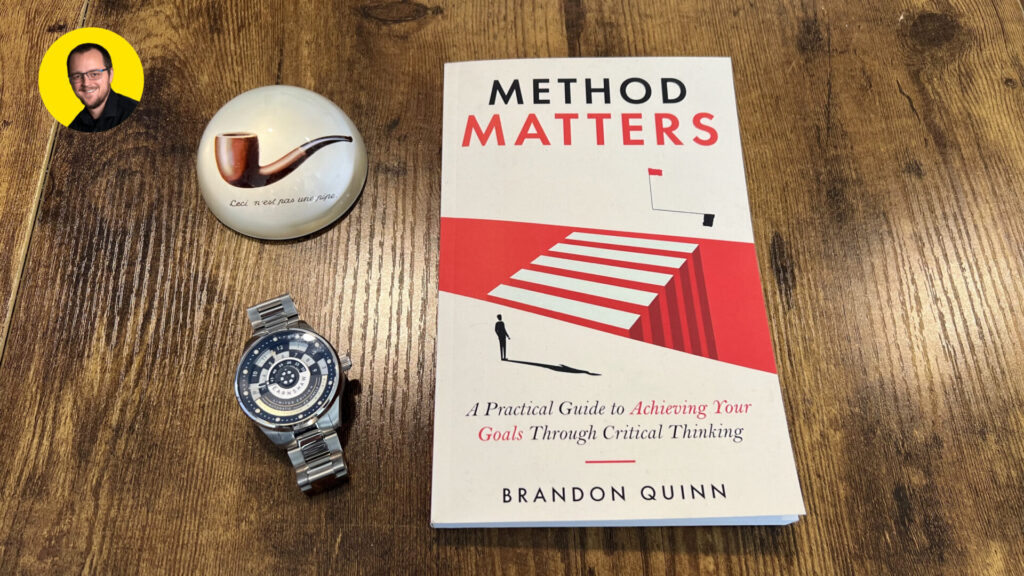
With my book’s recent publishing on Amazon, I’d like to share with you the full introduction chapter and a few images of the book! The section below contains the whole first chapter of the book as-is in the book, followed by a small collection of pictures I took of the book.
Introduction Chapter
Imagine for a moment you’re a cashier at a pretzel shop. You’re standing behind the cash register, talking to a customer. To your right is a display of pretzels of different shapes and sizes that extends to the wall. Behind you, within the eyeshot of the customer, there is a large oven, next to which is a table with pretzel dough in the shape of pretzels waiting to be baked. Everything in the store is clearly themed on pretzels and soft drinks. Now imagine your surprise when the customer asks you to make them a tuna hoagie with mayonnaise and a side of French fries.
This exact scenario happened to me nearly a decade ago. I had a summer job at a pretzel shop, which was a five-minute drive from my college dorm. One fine morning, a customer walks in, asks me for that tuna hoagie, and waits for me to jump into action. Instead, I stood there speechless, almost in a state of shock after hearing this request. I thought to myself, there is nothing in this building that suggests we make tuna sandwiches or sandwiches of any kind. There was no menu or boards with hoagie options, no food other than pretzels, and the word ‘pretzel’ was even in the store’s name, yet the customer asked for a tuna hoagie. Before I could think of anything to say, my manager walked to the counter from the back of the store to talk to her. He informed her that the deli she was looking for could be found a few buildings down the next block. I was not aware of this deli’s existence until that point.
After that revelation, the customer’s request made just a little bit of sense to me; it had at least some basis in reality. Beyond that, that customer failed to make basic observations of their surroundings. In a sense, I also failed, as I did not consider the possibility there was a deli nearby before my manager approached the customer. I had many such interactions with customers during my time there, and anyone who works a customer-facing job can tell you an embarrassingly high number of such interactions happen daily.
Now imagine a higher-stake situation: you’re a salesperson working on a $300,000 contract with a potential client. If everything goes well, the client will sign the contract, and you’ll receive a 10% commission of $30,000. You work with this potential client, and thanks to your efforts, everything goes well, and the client signs and submits payment to your manager. Unfortunately, your manager didn’t realize the bank would take a 0.1% fee from the payment, equal to $300. Instead of owning their mistake and eating the cost, your manager rejects the payment and asks your client to send over $300,300 to include that bank fee. The client was angry but was amicable enough to send another payment, which included the extra $300.
Unfortunately, your manager made the same mistake twice. After the bank takes its fee, your manager receives $299,999.70, 30 cents less than the target. In an unbelievable turn of events, your manager rejects your new client’s payment again and asks them to submit a third payment with the additional 30 cents. Your new client decides they don’t want to do business with someone who conducts themselves in this manner and pulls out. Your manager’s failure to think critically about their actions and how they would affect everyone caused your business to lose $300,000 in sales and you to lose $30,000 for yourself. The consequences in this example were much more severe than in the first, and this example is inspired by a real-world situation that took place in November of 2021.
This book will teach you how to apply methods of observation and reasoning to help ensure you never make a mistake like the ones above, especially in cases where time and money are on the line. We’ll use practical examples from my own experiences and real-world events to introduce and demonstrate essential concepts that you can apply directly to your job, personal projects, hobbies, and everyday life. We’ll discuss how to recognize blockers that can prevent you from adequately thinking critically and what to do when faced with them, including a strange example from the author of Sherlock Holmes himself. We’ll also discuss creativity techniques that you can use in situations where rational thinking isn’t enough to get the job done. Then, we’ll bring it all together to show you how you can plan, execute, and complete your personal and professional goals with the full force of practical critical thinking.
I’ve written this book for people who are career-focused and project-oriented. Most books on reasoning and critical thinking spend too much time on technical jargon and dry lists of logical implications and fallacies, but this book omits that in favor of practical explanations and ready-to-use methods. If I’ve done my job as an author correctly, you will walk away with a new set of skills you can apply to all your goals, projects, and important decisions. More importantly, you will be able to think critically habitually.
We’ll start with a light introduction to critical thinking at a high level. Then, we’ll dedicate chapters to dive into each component of critical thinking, outline how to apply methods of critical thinking, and demonstrate their application with real-world examples, some of which come from my own experience. After you’ve learned and mastered those concepts, we’ll move on to discuss how to apply critical thinking over large periods of time, how to use methods of reasoning to think about your goals, ways of thinking creatively that expand beyond the confines of logic, how to recognize and mitigate blockers of critical thinking, and finally, bring it all together to outline how you can use these concepts to plan and drive your goals for success.

By Quinn, Brandon (Paperback)
Book Photos
These are photos I took using a few author copies of the book, as well as a few personal belongings of mine.
Subscribe
Stay up-to-date on new book launches and major announcements.
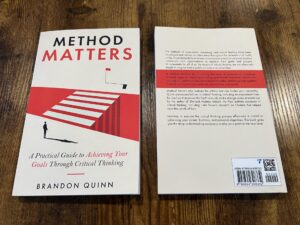
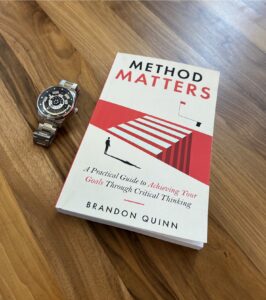
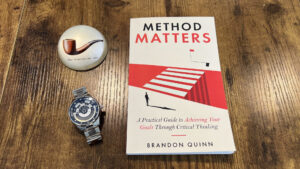
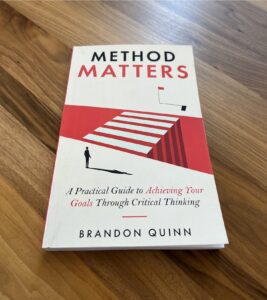
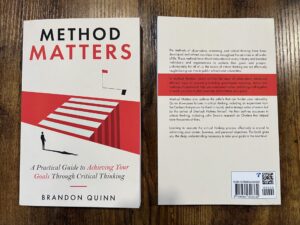
One thought on “The Complete First Chapter of “Method Matters””